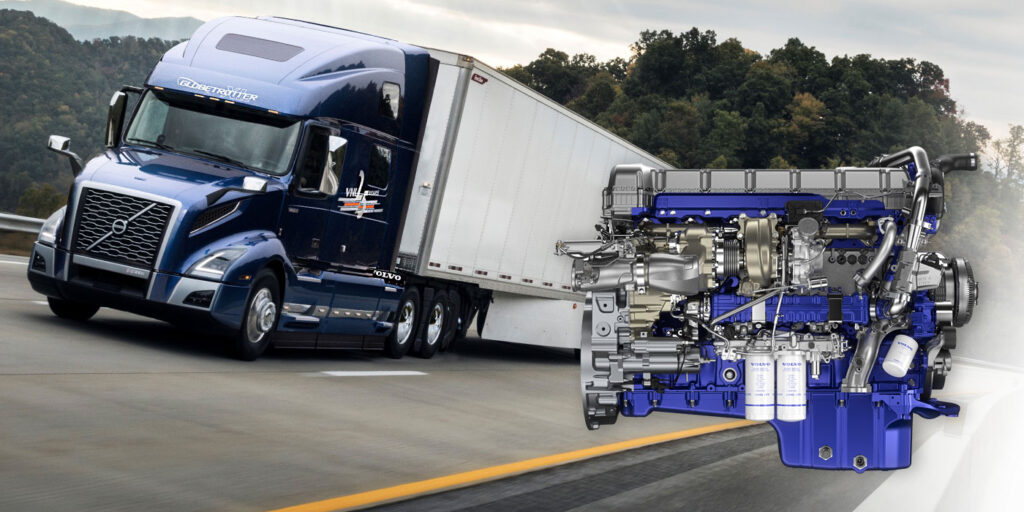Biodiesel has been cropping up in more decarbonization conversations as the industry drives toward lower (and sooner than you think: zero) emissions. Volvo Trucks North America mentioned biodiesel during its ATA MCE press conference. While we’ve had the likes of REG talking about the potential benefits of biodiesel, its appeal seems to be gaining a wider audience.
I had the chance to talk with Johan Agebrand, director of product marketing, Volvo Trucks North America, on an array of diesel engine issues. The conversation moved quickly, bouncing from biodiesel to aftertreatment to what’s on the horizon for the next iteration of truck equipment. So here’s Agebrand on…
The potential of biodiesel.
“The internal combustion engine is going to be one technology in the mix of different technologies that move toward reduced emissions. One thing we’re asking is: What kind of fuel do we use in that internal combustion engine? Is it going to be pure diesel? Are we going to look at a synthetically produced diesel, which is a very good environmental solution, depending on if the infrastructure exists? It all comes down to the big picture of infrastructure, and I think that’s the big discussion going on in the industry.”
But just how viable is biodiesel, from Agebrand’s perspective, if the infrastructure is there to deliver it?
“We can do biodiesel today; it is being used in Europe,” he said. “B100, depending on how you produce it, could have CO2-neutral aspects to it when it comes to the fuel usage life cycle, but you have to consider how it is produced. I think that’s the next step. We have to talk about the fuel lifecycle like we do when we talk about our Volvo CO2-neutral factories and CO2-neutral material. To really be sustainable in the future, that’s where we need to go.”
Reducing aftertreatment headaches.
There’s a lot of EV buzz, but for the next 10 to 15 years, diesel will still be the king of the highway. (For reference, Volvo Trucks North America aims to have a completely CO2-neutral equipment offering by 2040.) With diesel powertrains come aftertreatment systems, which have been a bane of fleet service departments for decades. But that characterization isn’t quite fair given how far aftertreatment systems have come from the early days of SCR and EGR to today’s one-box aftertreatment systems.
“The industry has learned a lot,” Agebrand said of developing more reliable aftertreatment systems. “The key is keeping the temperature up in the system; how we insulate the systems. In the early days of aftertreatment, the systems would have some kind of extra fire blanket carpet on the pipes. Today, that insulation is built-in, like a thermos, with a double-layered pipe. There are a lot of things that have progressed, which means that it’s a much more robust system. Today’s one-box systems can’t be impacted by the environment or incorrect servicing: Did you put that blanket on correctly? Did you clamp it down right? The one-box aftertreatment system created its own little case and installation.”
What about the next iteration of aftertreatment systems?
“It’s always going to be a question of how you package the system,” he said. “You’re always going to have a bit of a fight between size and layout on the chassis and packaging. We can design them in a better way potentially to keep them in the same footprint, but still have more volume, or they need to get longer, or have a bigger diameter, et cetera.”
Agrebrand noted that development of new equipment and technology is interlinked. Think about the first cell phone you have compared with the one you’re likely reading this story on. As technology develops, it scales down, becomes more efficient and more stable.
There’s massive amounts of data coming off today’s trucks that inform future equipment development decisions, but at the end of the day, Agebrand stressed that the future development of a technology comes down to its base design. In his words, “you can only compensate so much.”
The improvement leaps between truck hardware and software.
“Hardware has a longer development cycle compared with software because of production needs or materials or something else. But, you take larger leaps when you improve hardware,” Agebrand said. “After you improve the hardware, you do maybe three or four quick leaps of software advancements that squeeze out a lot of fuel efficiency in the existing products.”
He pointed to the fuel injection system as an example.
“We changed the pistons. We changed the compression. We changed the nozzles on the injectors and how they inject, but the way we pull the fuel to the injection system hasn’t really differed,” he said just before offering this eyebrow-raising insight:
“I’m convinced that if any OEM did absolutely nothing new with engine hardware and they let the software engineers work, you’re probably going to get 3% to 4% fuel efficiency gains a year because of how they’ll come up with stuff that you’ve never thought of on the hardware side.”
More from Agebrand
When talking with Volvo Trucks North America’s president Peter Voorhoeve, we pulled Agebrand into the conversation to detail diesel’s role in fleet decarbonization. To hear more about the current decarbonization impact of turbo compounding and other diesel technology, click below to read that story:














